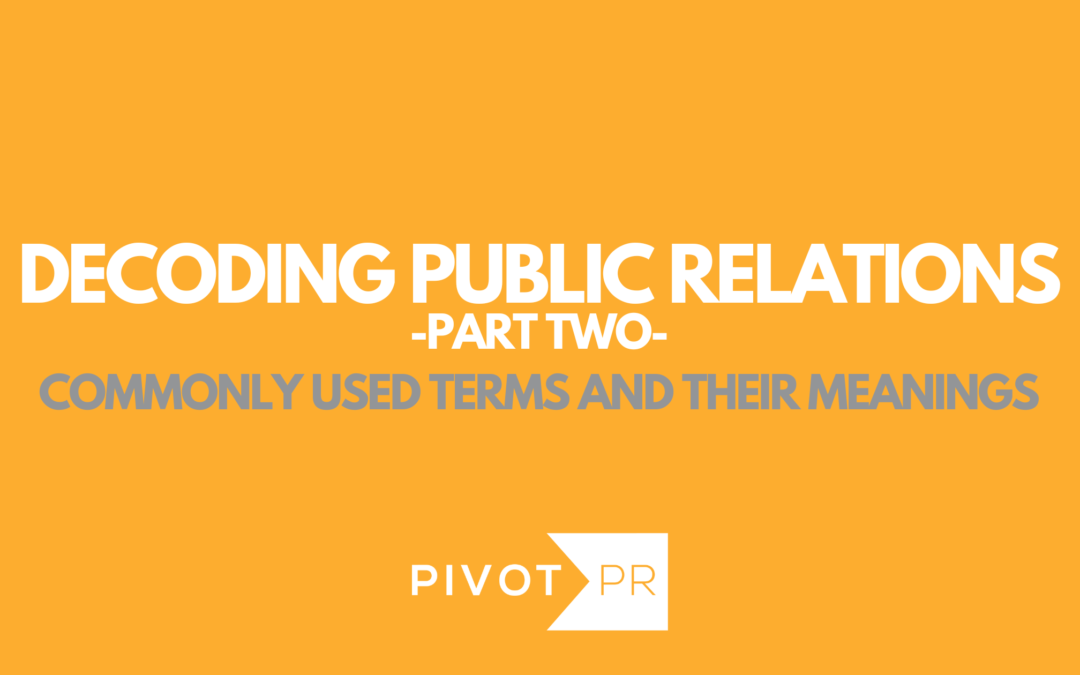The world of public relations is jam packed with terms that can sometimes be a tad bit confusing. But don’t worry, we’re back with a sequel of “Decoding Public Relations” to further demystify some of the top phrases we see floating around in our world constantly, and what they really mean!
In this post, we will focus on ten terms specifically used in the public relations industry, carefully defining how they are used in the context of PR.
Op-Ed
Contrary to popular belief, Op-Ed does not stand for “opinion editorial.” Surprised? We were, too!
Short for “opposite the editorial,” an op-ed is an opinion piece that appears in a newspaper. This content is commonly written by a subject-matter expert, a person with a unique perspective on an issue, or a regular columnist employed by the paper. It is called “opposite the editorial” because newspapers typically place op-eds on the opposite side of an editorial page.
SEO
Ever wonder how some websites pop up on the first page of your Google search, while others are hidden in the endless scroll of later pages? That’s (SEO) magic at work. By optimizing website content with relevant keywords, tags, and backlinks, brands can increase their visibility and rank higher in search results. Consider it the behind-the-scenes work to make your website the star of the Google show.
Social Listening
Social listening allows businesses to track mentions of their brand, competitors, or their general industry online through social media, without the consumer interacting with the brands owned channels. These mentions help brands understand what consumers are saying online organically. Once a brand has this information, they can use it to tailor content, address concerns, and engage with the audience in meaningful ways.
For example: a consumer posts on Facebook asking if anyone has a recommendation for a good running shoe. One of their friends might comment “Adidas” or “Nike,” without tagging the brand. If multiple people are having a similar conversation, i.e. associating Adidas or Nike with good running shoes, this will come up as a spike in Nike / Adidas social listening. They can see that they (or their competitor) were included in numerous conversations about running shoes, which might help them better target their strategy.
Boilerplate
At the end of a press release, you often see a paragraph that seems to repeat across different releases from the same company. That’s the boilerplate. It’s a standardized text that provides a brief overview of the company, including its mission, achievements, and services.
Byline
Have you ever noticed a name right below the headline of an article? In the media world, that is called a byline. It gives credit to the author of the article.
Geotargeting
Geotargeting is a strategy that pushes content or advertisements to users based on their geographic locations. It is most commonly used by businesses who are trying to reach people in a specific area. For example, a restaurant might use geotargeting to reach people within a certain radius of their location. Anyone outside that radius might not find the ad relevant.
Influencer Marketing
Influencer marketing is when a brand taps trusted influential partners to promote a product, bridging the gap between the consumer and the brand. Influencers—ranging from content creators, micro or macro influencers, to revenue driving influencers and celebrities—are carefully selected based on the brand’s specific goals. No surprise here: the content they produce is also reflective of these goals. For example, if your goal is to sell more product, you would want to partner with an influencer who is known for driving revenue, and ask them to create a piece of content specifically encouraging their followers to buy your product.
Whitelisting
Whitelisting is an up-and-coming topic within influencer marketing. It is when a brand is given access to an influencers account and has the green light to run ads on their behalf from their channel. This arrangement tends to be a win-win: the brand gets to tap into an audience already receptive to similar content, while the influencer enjoys the perk of increased exposure through the brand’s targeted social ads.
Click-Through Rate (CTR)
Click-through rate tells you the percentage of people who click on a link or ad after seeing it. High CTR? Your ad is working! Low CTR? It might be time to try a new approach.
EdCal
An editorial calendar is a list of topics that will be discussed monthly in a magazine. It is often intended for potential advertisers; However, PR teams can also leverage this information! Many public relations professionals will use an EdCal as a strategic planning tool to help align their pitches with the media’s scheduled focus areas.
NDA
A Non-Disclosure Agreement (also referred to as an NDA) is not specific to the PR industry. However, in the realms of public relations, a Non-Disclosure Agreement (NDA) acts as a confidentiality safeguard. It legally binds all parties involved—agencies, consultants, clients, and freelancers—not to disclose proprietary insights or creative ideas until a certain date, usually the launch or release date. Having an NDA in place ensures that any sensitive information related to PR strategies, campaign specifics, client details, or product launches remains under wraps.
Whether you’re crafting your next Op-Ed or analyzing your latest campaign’s CTR, knowing these terms will help you navigate the ever-evolving landscape of public relations with ease. In case you missed it, be sure to check out our first blog post on this topic: https://pivot-pr.com/decodingpublicrelations/
